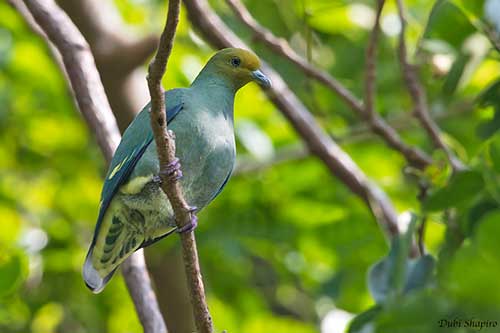
The female lays a single white egg, and both adults incubate and tend the chick.
Because of the low protein content of fruit, the fruit-eater doves must invest more energy in egg production than seed-eaters, but also in raising their chick.
PROTECTION / THREATS / STATUS:
The Tanna Fruit Dove can be found in suitable habitat, but it is reported to be only moderately common. It is threatened by habitat loss through logging and by degradation of the large fruiting trees. Hunting could be a threat too, but the species is partly protected by law.
The population is suspected to be slowly declining.
The Tanna Fruit Dove is currently evaluated as Least Concern.
Fr: Ptilope de Tanna
Ang: Tanna Fruit Dove
All: Silberfleck-Fruchttaube
Esp: Tilopo de Tanna
Ita: Tortora beccafrutta di Tanna
Nd: Vanuatujufferduif
Sd: vanuatufruktduva
Photographer:
Dubi Shapiro
Dubi Shapiro Photo Galleries & Dubi Shapiro's Pictures on IBC
Text by Nicole Bouglouan
Sources:
HANDBOOK OF THE BIRDS OF THE WORLD vol 4 by Josep del Hoyo-Andrew Elliott-Jordi Sargatal - Lynx Edicions - ISBN: 8487334229
PIGEONS AND DOVES by David Gibbs, Eustace Barnes and John Cox - Pica Press Sussex - ISBN: 1873403607
Birds of Melanesia: Bismarcks, Solomons, Vanuatu and New Caledonia Par Guy Dutson – Editeur : Bloomsbury Publishing, 2011 – ISBN: 1408152460, 9781408152461
Phylogeny and biogeography of the fruit doves (Aves: Columbidae)
Tanna Fruit Dove
Ptilinopus tannensis
Columbiformes Order – Columbidae Family
INTRODUCTION:
The Tanna Fruit Dove is endemic to Vanuatu where it frequents a variety of wooded habitats. It is frugivorous, giving the bird its name.
The genus Ptilinopus is part of the subfamily Treroninae in the large family Columbidae. The fruit doves are usually heavily built and short-tailed, and these features are closely related to their arboreal behaviour. These doves swallow the fruits whole, thanks to their well-adapted gizzard with hard ridges and nodules which rub the fruit. The indigested parts are later expelled whole.
The Tanna Fruit Dove is affected by habitat loss through commercial logging, but the species is currently not globally threated.
DESCRIPTION OF THE BIRD:
Biometrics:
Length: M: 24-27 cm – F: 23-26 cm
The Tanna Fruit Dove adult male has olive yellow forehead and lores to mid-crown, becoming mostly olive on hindcrown and neck. The plumage is dark green overall, but on the upperwing, scapulars and some of the inner lesser wing-coverts are silvery-grey centrally, and form a patch of silver spots on the shoulder. The yellow tips or fringes to the outer webs of most of greater coverts and secondaries form two yellow patches on the wing. The tail is dark green, but central rectrices show indistinct silvery-green subterminal band, whereas outer rectrices have paler silvery subterminal bands.

Female at the top
and
male at the bottom
On the dark green underparts, the belly is more olive with faint yellow fringes to some feathers. Thigh feathers are deep olive with broad yellow tips. Vent and undertail-coverts are lemon-yellow with olive central spots on inner webs. The undertail is greyish with paler subterminal area. The underwing is slaty-grey, but the coverts are tinged green with narrow pale yellow fringes.
The bill is bluish-grey. The eyes are whitish. Legs and feet are purplish-red.
The female resembles male but she lacks the silver spots on the shoulders, and the lower belly is mostly white, less yellow than in male.
The juvenile has green plumage with yellow fringes, forming scaly effect. It has brown eyes and very pale red legs and feet.
RANGE:
The Tanna Fruit Dove is found in Vanuatu and Banks Islands.
HABITAT:
The Tanna Fruit Dove frequents a wide variety of wooded habitats with tall fruiting trees. It can be found in rainforest, open woodland, plantations, parks and gardens. It is less common or absent in montane and degraded or dry forests.
CALLS AND SONGS: SOUNDS BY XENO-CANTO
The Tanna Fruit Dove’s advertising call is a series of six slow “coo” notes, or deep, fairly loud “woo” sometimes given in succession when the birds are chasing each other. These notes increase gradually in pitch before to end abruptly.

BEHAVIOUR IN THE WILD:
The Tanna Fruit Dove is exclusively frugivorous. It feeds on fruits of various plant species such as Ficus, Dysoxylum, vines and palms. It feeds in the canopy where it can be seen singly or in pairs, but also in small groups. However, larger flocks may gather at abundant fruit sources. Fruits are swallowed whole.
This species is shy and usually remains in the dense foliage of the canopy where it is difficult to see. As a typical arboreal species, it is able to grip a branch strongly and to hang upside-down while feeding.
Like most of Columbidae, the Tanna Fruit Dove forms monogamous pair-bonds, at least for a season. The breeding period starts with displays including advertising, pair formation, nest building, but also aggression and defence. The courtship displays are probably typical of this family.
The Tanna Fruit Dove performs some movements associated with fruit abundance, and probably travels between islands.
The broad wings give the bird great manoeuvrability during the flight. Doves are usually good fliers.
REPRODUCTION OF THIS SPECIES:
Breeding birds have been recorded in April and May, but the season is probably more extended with more than one brood per year.
The Tanna Fruit Dove builds a flimsy platform with twigs loosely interwoven. This structure is placed high up in tree, often on horizontal fork.
